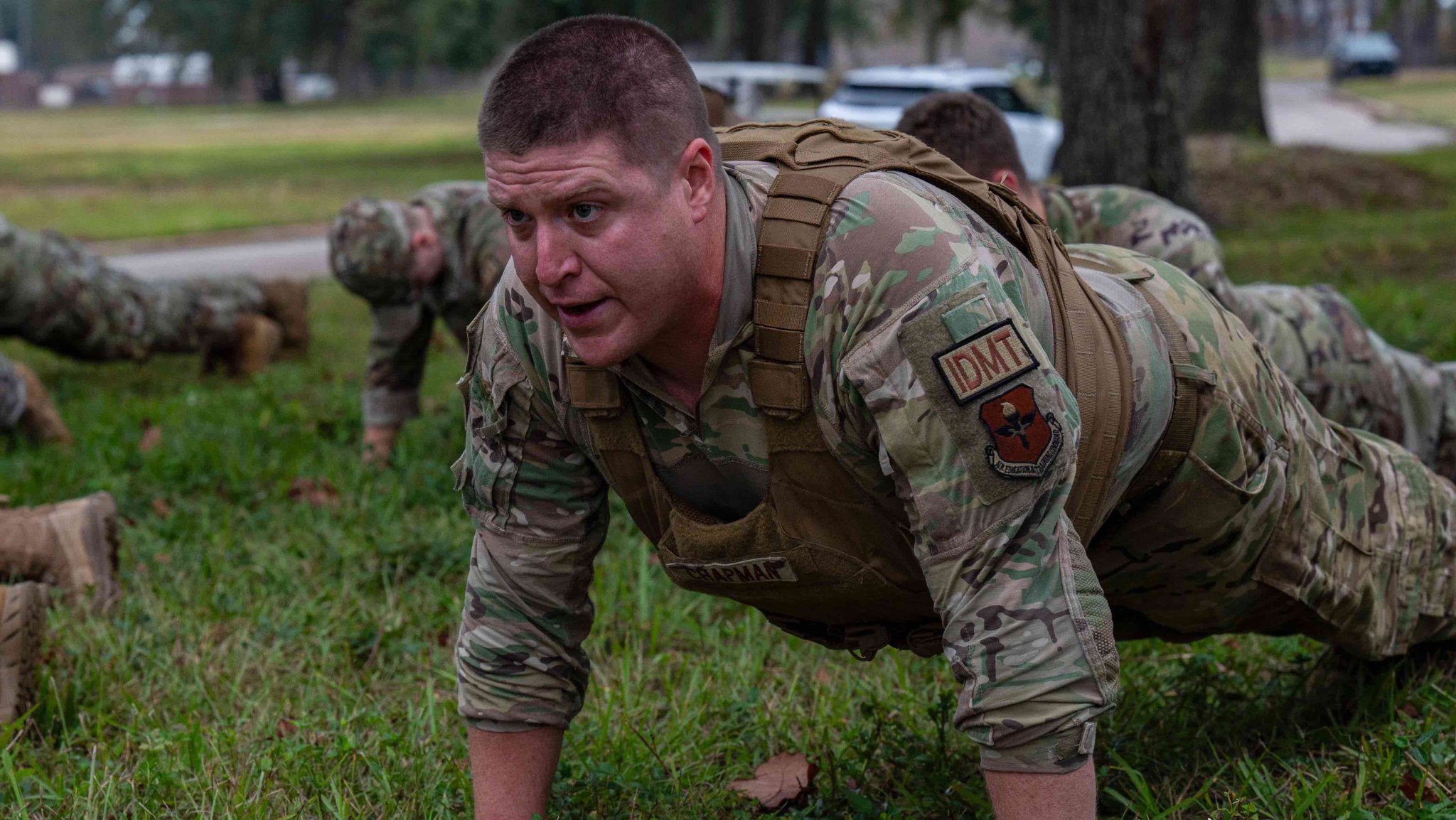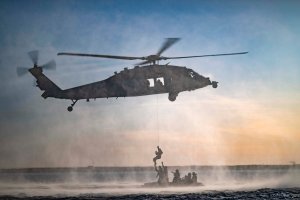
Air Force Master Sgt. Caige Chapman, 81st Operational Medical Readiness Squadron, independent duty medical technician, participates in memorial push ups during Warrior Day on Keesler Air Force Base, Mississippi, Nov 8, 2024. Air Force photo by Senior Airman Trenten Walters.
The Air Force is likely to up its fitness standards, including the addition of a 2-mile run and twice-yearly testing, Air Force officials confirmed to Task & Purpose.
“Yes, PT changes are coming,” Chief Master Sergeant of the Air Force David Flosi wrote in a post on that was widely distributed to Air Force leaders on Microsoft Teams last Thursday. Officials in Flosi’s office provided Task & Purpose with a copy of the note, part of which first circulated on social media, including the Air Force amn/nco/snco Facebook group.
Though officials said changes to the current Air Force standards are “pre-decisional,” Flosi wrote that he expected a longer run, a return to a new version of “tape test” measurements, and for PT tests to be administered twice each year.
Flosi sent the note last Thursday, an official said, as a call for general readiness as Air Force personnel were scrambling into sudden deployments as the U.S. considered joining Israeli airstrikes against Iran.
“These Airmen join many thousands already on missions around the world, from embedded SOF in all COCOMs, to our institutional Airmen building, training and educating the force, to the Minuteman III force on alert and ready to go right now,” Flosi wrote. “Any day could be the day.”
‘The day,’ it turned out, was two days later, as B-2’s led strikes on Iranian nuclear sites as part of Operation Midnight Hammer.
An Air Force spokesperson said no details would be available on specific new requirements until they are finalized.
“The Air Force is finalizing updates to its Physical Fitness Assessment following a comprehensive ten-month review,” the spokesperson said in an emailed statement. “Updates to the program will be formally released once the guidance is finalized.”
Air Force’s changing PT standards
The Air Force’s current PT test includes a 1.5-mile run, push-ups and a core abdominal event, and is administered annually. The Air Force’s tests have moved toward more traditional fitness events like runs and calisthenics in recent years, after several decades of less rigorous tests.
In the 1940s, the Air Force adopted a plan of “aviation calisthenics,” according to a 2023 history of Air Force fitness compiled by the service. That workout program included sit-ups, pull-ups, and a 300-yard shuttle run. In the early 1960s, the service adopted the “Five Basic Exercises” program, which was a tiered series of different exercises, from beginner level to advanced, ranging from arm circles and push-ups to ballet-like split-jumps.
In 1969, the Air Force released the Aerobics Physical Fitness Program, which included the first mandatory 1.5-mile run. The program’s name was coined an Air Force flight surgeon at Wilford Hall in San Antonio, Texas, launching the term that would become ubiquitous during the fitness surges of the 1970s and 1980s.
The Air Force used only a 1.5-mile run as its annual test through the 1980s, according to a RAND study of Air Force fitness requirements published in 2021. From 1992 to 2003, the Air Force used a “cycle ergometer,” or stationary bike, to assess fitness across the force, but that test was scrapped in 2004 when Air Force Chief of Staff Gen. John P. Jumper decreed it “was not consistent with the growing demands of our warrior culture.”
The 1.5-mile run returned in 2004, adding push-ups and sit-ups.
Get Task & Purpose in Your Inbox
Sign up for Task & Purpose Today to get the latest in military news each morning, and The Pentagon Rundown for a weekly breakdown of the biggest stories every Friday.
The “tape test” has been an on-again/off-again part of Air Force body composition standards for close to a decade. A test that measured only waist circumference was dropped in 2020, but the new version, Flosi said, may be based on height-to-waist ratios.
A 2016 National Institute of Health study found that the height-to-waist ratio “is a more sensitive universal screening tool than [body mass index] to detect health risks” across gender and a wide range of ages. Generally, the NIH found, a ratio of 0.5, in which a person’s waist measure is one-half of their height or less, “can be used in different sex and ethnic groups and is generally accepted as a universal cutoff for central obesity in children (aged ≥6 years) and adults.”
PT tests across the military
Fitness tests and standards have long been a central part of military identity, and leaders of every service often tweak or even overhaul them.
The Army spent close to a decade rolling out it’s 6-event Army Combat Fitness Test, then revised it earlier this year — rebranding as the Army Fitness Test — by removing an overhead throw event, universally referred to as the “yeet.”
The Marine Corps’s first fitness test in the 1950s was almost laughably easy by current standards, with a passing score achievable with three chin-ups, 25 sit-ups, and just 21 push-ups. Today, Marines take both a (much harder) traditional fitness test with a 3-mile run and strength events, and the grueling Marine Combat Fitness Test, a monster-mash-style functional fitness test that includes buddy carries and lifting sand-filled ammo cans.
The service-wide fitness test most similar to the Air Force’s is the Navy Physical Readiness Test, which includes a 1.5-mile run and traditional calisthenics. But perhaps appropriately, one of its alternative events sets it apart from any of the other three services.
Unlike airmen, soldiers, or Marines, sailors nursing injuries that keep them from running can choose to swim.
The latest on Task & Purpose
- An Army base will now honor a Buffalo Soldier
- 2 aircraft carriers, 9 destroyers, and multiple fighter wings gather in the Middle East
- Marines and sailors are building trenches for the drone age
- The Army is deactivating police units in deep cuts to number of military cops
- Military intelligence battalion sergeant major arrested for DUI and suspended

Task & Purpose Video
Each week on Tuesdays and Fridays our team will bring you analysis of military tech, tactics, and doctrine.
.png)




